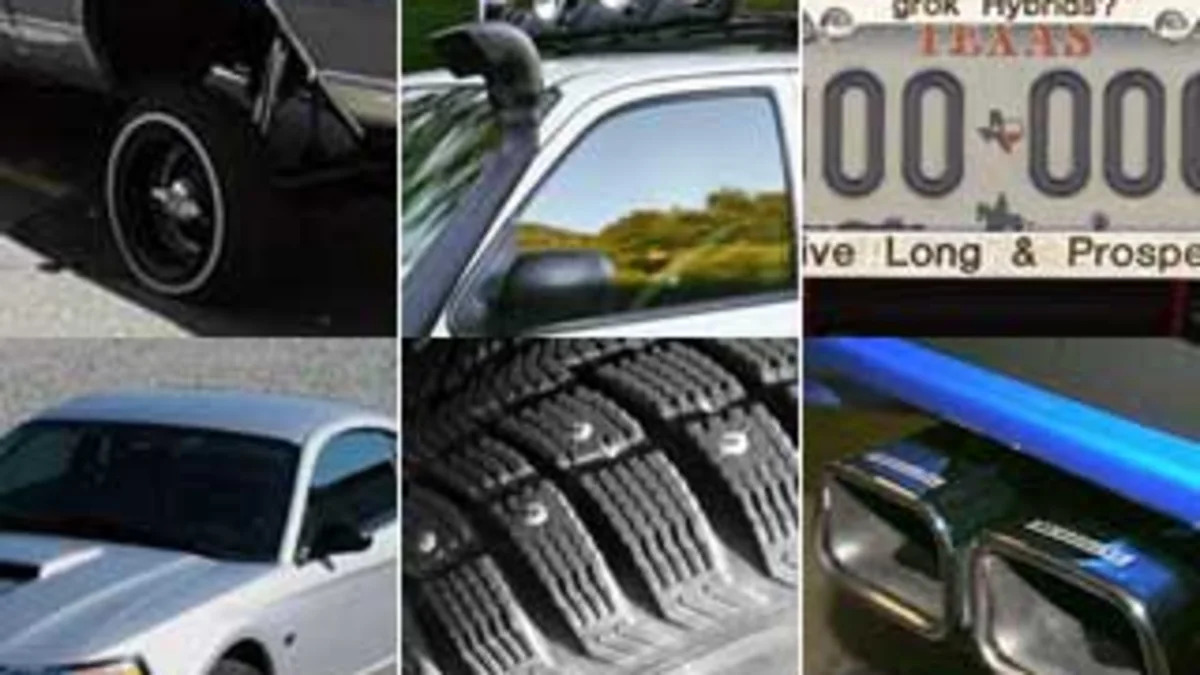Car Mods: Street Legal, Locally Illegal?
Sep 22, 2009

-

Not only might an accessorized look that hits the mark in San Diego not play in Peoria, it might not be legal there. And take an off-road lifted, window-tinted, modified truck to quaint, coastal New England, and you might just get a ticket.
Local and state rules for accessories and vehicle modification vary greatly. States can’t issue regulations that conflict with federal standards (FMVSS), which set performance requirements, not design requirements for vehicles; but states are free to establish their own regulations and rules where ones from the federal government don’t already exist. And they certainly have.
Beyond obvious upkeep issues like rust, leaky exhausts, and headlights that don’t work, here are ten rather unexpected reasons why, within the U.S. your vehicle might be street-legal in one place and illegal in another.- More On Car Safety & Modifications:
- Monkey Mask Prevents Speeding Tickets
- Car Safety
- Bizarre Car Accidents
-
Window Tinting
This one’s frustrating. Almost every state law has its own rules on window tinting -- especially light transmittance, usually given as a percentage -- and they’re all over the place. Regulations typically range from 50 or 70 percent for the driver’s side in much of the upper Midwest and East Coast (a very light tint) to less than 30 percent in many Southern states. To complicate matters more, some states place more of a restriction on the driver’s side window. Get a lighter tint in the first place, and you’re much less likely to run into trouble when you move and re-register.- More On Car Safety & Modifications:
- Monkey Mask Prevents Speeding Tickets
- Car Safety
- Bizarre Car Accidents
-
Aftermarket Catalytic Converter
Under the tighter new emissions-check system employed by the state of California, if you’ve recently replaced your catalytic converter -- especially in another state -- with one that’s not official original equipment (OE), you might not be legal in the Golden State. Check CARB’s Web site to make sure that you are. If you have an aftermarket catalytic converter that was installed before January 1, 2009 and is otherwise functioning, you should be okay.- More On Car Safety & Modifications:
- Monkey Mask Prevents Speeding Tickets
- Car Safety
- Bizarre Car Accidents
-
HID Headlamp Kits
You might be able to get a very functional, reliable, and sophisticated aftermarket installation of modern high-intensity discharge (HID) headlamps, but no matter how perfect, they’re not legal -- anywhere in the U.S. Even if you can adjust your added-on HID lamps to federal photometric standards, the National Highway Traffic Safety Administration (NHTSA) has determined that no HID headlamp can comply with the federal standard. Be forewarned, if you have a model that doesn’t typically have HID headlamps, you’ll get a ticket in most states.- More On Car Safety & Modifications:
- Monkey Mask Prevents Speeding Tickets
- Car Safety
- Bizarre Car Accidents
-
Off-Road Lamps
These powerful lights, often 100 watts or more each, are sometimes mounted in a bar on the roof or around the grille of a vehicle. Because of their high intensity, diffused light pattern, and long range, these beams can be dangerous to oncoming road traffic. You might have known that, but you might not have realized that in some states, if you don’t keep off-road lamps physically covered when you’re not off-roading, they’re technically illegal. Yes, even when they’re turned off.- More On Car Safety & Modifications:
- Monkey Mask Prevents Speeding Tickets
- Car Safety
- Bizarre Car Accidents
-
License Plate Frames
The plastic or metal frames that hold your license plate in place, keep it from rattling, and possibly advertise your dealership might be illegal in some states. Arizona just last year introduced new requirements -- partly because of the number of state-issued custom and vanity plates -- that specified that “Arizona” must be showing, not covered up by a top section of the frame. As for those tinted or reflective license-plate covers: they’re illegal in most states.- More On Car Safety & Modifications:
- Monkey Mask Prevents Speeding Tickets
- Car Safety
- Bizarre Car Accidents




